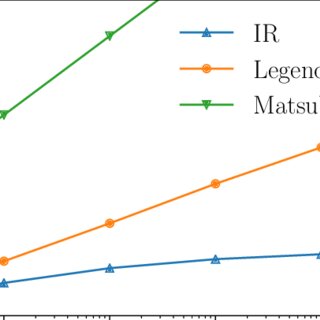September 2022
·
16 Reads
·
19 Citations
SciPost Physics Lecture Notes
This lecture note reviews recently proposed sparse-modeling approaches for efficient ab initio many-body calculations based on the data compression of Green's functions. The sparse-modeling techniques are based on a compact orthogonal basis, an intermediate representation (IR) basis, for imaginary-time and Matsubara Green's functions. A sparse sampling method based on the IR basis enables solving diagrammatic equations efficiently. We describe the basic properties of the IR basis, the sparse sampling method and its applications to ab initio calculations based on the GW approximation and the Migdal--Eliashberg theory. We also describe a numerical library for the IR basis and the sparse sampling method, sparse-ir, and provide its sample codes. This lecture note follows the Japanese review article [H. Shinaoka et al., Solid State Physics 56(6), 301 (2021)].







![Figure 9: Condition number of the IR transformation matricesˆFmatricesˆ matricesˆF F and F F [12]. Left panel shows the condition number of frequency transformation matricesˆFmatricesˆ matricesˆF F as a function of basis size N = L, in comparison with the Chebyshev representation. Right panel shows the condition number of both τ and iω n transformation matrices with respect to Λ, where N is chosen to be the maximum number of coefficients with the same cutoff in singular values S α l , provided in the irbasis library [27].](https://www.researchgate.net/publication/353068973/figure/fig3/AS:1043164987129858@1625721322773/Condition-number-of-the-IR-transformation-matricesFmatrices-matricesF-F-and-F-F-12_Q320.jpg)





![FIG. 12. Total energy E tot with Monte Carlo errors for H 10 with STO-6g (left column) and cc-pVDZ (right column) basis. ED results are used as reference for STO-6g and MRCI+Q (T = 0) from Ref. [59] for cc-pVDZ. Top panels: Comparison of reference data and CDet at different k max at finite temperature T = 50 −1 E h , along with ED and CCSD results at T = 0 for STO-6g basis. Middle panel: Total energy with Hartree-Fock contribution removed. Bottom panels: Difference between CDet and reference data at finite temperature (for STO-6g), in comparison to difference between CCSD and ED at zero temperature.](https://www.researchgate.net/publication/343506624/figure/fig4/AS:929534526386176@1598629709285/Total-energy-E-tot-with-Monte-Carlo-errors-for-H-10-with-STO-6g-left-column-and-cc-pVDZ_Q320.jpg)



![FIG. 2. Kernel density estimation[57-59] of the percent of the SHCI-computed correlation energy within each basis obtained by each of the methods in the benchmark set. All basis sets available are plotted; individual data points are indicated by small lines.](https://www.researchgate.net/profile/Fabien-Bruneval/publication/336208146/figure/fig1/AS:809393490771968@1569985854911/Kernel-density-estimation57-59-of-the-percent-of-the-SHCI-computed-correlation-energy_Q320.jpg)




